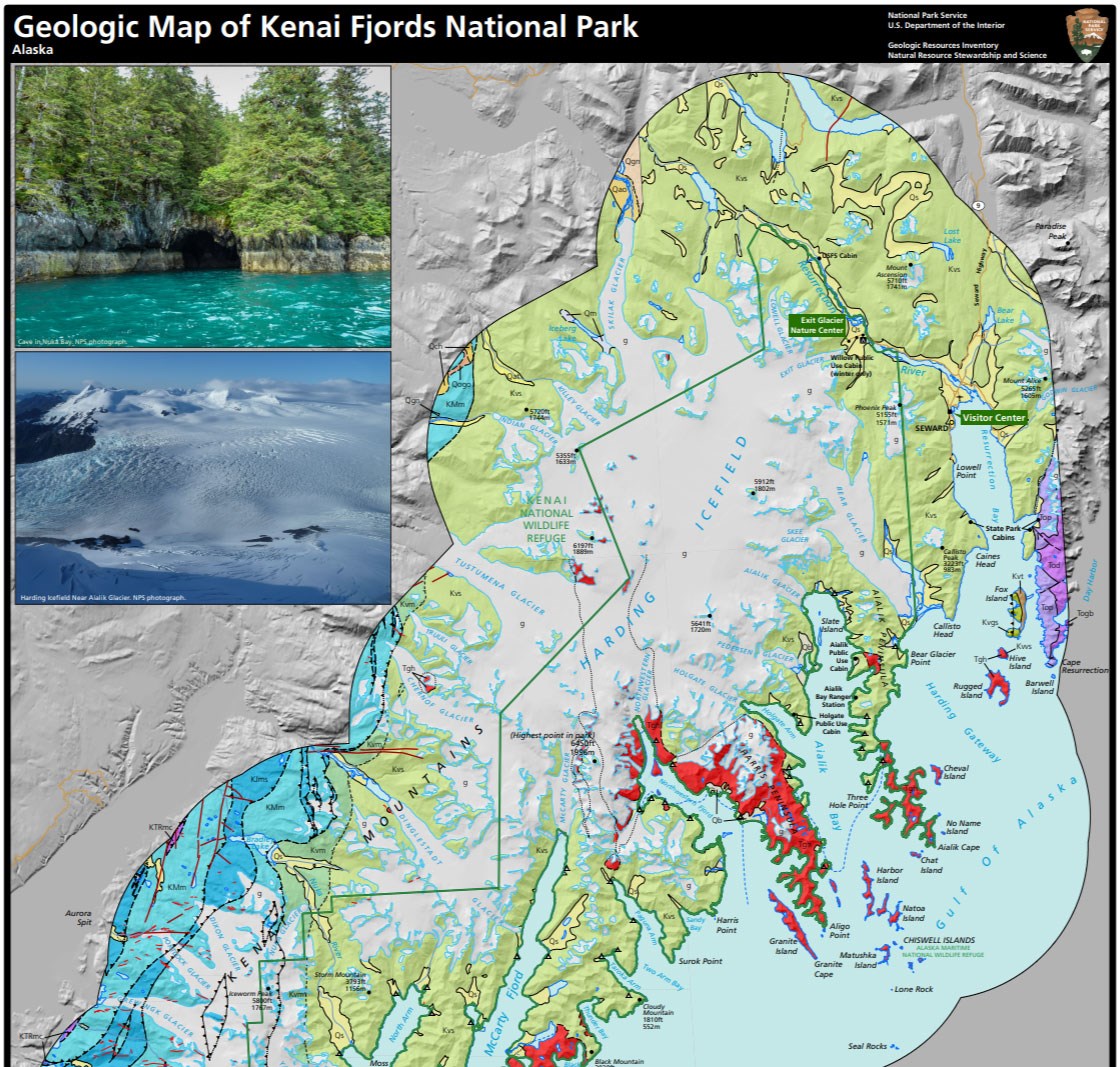Last updated: July 9, 2024
Article
NPS Geodiversity Atlas—Kenai Fjords National Park, Alaska
Geodiversity refers to the full variety of natural geologic (rocks, minerals, sediments, fossils, landforms, and physical processes) and soil resources and processes that occur in the park. A product of the Geologic Resources Inventory, the NPS Geodiversity Atlas delivers information in support of education, Geoconservation, and integrated management of living (biotic) and non-living (abiotic) components of the ecosystem.

Introduction
Kenai Fjords National Park (KEFJ) is located on the southeastern side of the Kenai Peninsula approximately 100 km (62 mi) south of Anchorage in the Kenai Peninsula Borough, Alaska. Originally proclaimed a national monument on December 1, 1978, the park unit was redesignated as a national park on December 2, 1980 (Anderson 2017). The park encompasses nearly 271,132 hectares (669,984 acres) of rugged glacial landscape that is home to a diverse biological community that includes bears, moose, seals, sea lions, sea otters, and seabirds. The park includes the 2,072 km2 (800 mi2 ) Harding Icefield, coastal fjords, coastal islands, ecosystems they host, and the outflowing glaciers that feed into them (Lanik et al. 2018).Geologic Setting
The geology of Kenai Fjords National Park reflects a geologically active landscape that has been heavily influenced by plate tectonic processes and glaciation. Distinctive landforms in KEFJ reflect the powerful erosive forces of ice and include steep-sided fjords, rocky cliffs, recently deglaciated mountainsides, active glaciers, and the Harding Icefield (Lanik et al. 2018). The bedrock geology of the park is part of the Chugach–Prince William accretionary complex emplaced against the continental margin during Late Cretaceous and Tertiary subduction. Rocks of the accretionary complex range in age from possibly latest Jurassic to potentially as young as Eocene (~150–33 million years ago), and include marine sedimentary rocks scraped off the subducting oceanic plate, as well as sedimentary debris shed from the overriding landmass (Figure 18; Lanik et al. 2018). Geologic units of the park include rocks of the Cretaceous McHugh Complex, Late Cretaceous Valdez Group, Paleocene to Eocene Orca Group, Pleistocene and Holocene glacial deposits, and Quaternary beach and alluvium deposits.- Scoping summaries are records of scoping meetings where NPS staff and local geologists determined the park’s geologic mapping plan and what content should be included in the report.
- Digital geologic maps include files for viewing in GIS software, a guide to using the data, and a document with ancillary map information. Newer products also include data viewable in Google Earth and online map services.
- Reports use the maps to discuss the park’s setting and significance, notable geologic features and processes, geologic resource management issues, and geologic history.
- Posters are a static view of the GIS data in PDF format. Newer posters include aerial imagery or shaded relief and other park information. They are also included with the reports.
- Projects list basic information about the program and all products available for a park.
Source: NPS DataStore Saved Search 2916. To search for additional information, visit the NPS DataStore.
A NPS Soil Resources Inventory project has been completed for Kenai Fjords National Park and can be found on the NPS Data Store.
Source: NPS DataStore Saved Search 2988. To search for additional information, visit the NPS DataStore.
GRI Geology Image Gallery

Related Links
National Park Service Geodiversity Atlas
The servicewide Geodiversity Atlas provides information on geoheritage and geodiversity resources and values within the National Park System. This information supports science-based geoconservation and interpretation in the NPS, as well as STEM education in schools, museums, and field camps. The NPS Geologic Resources Division and many parks work with National and International geoconservation communities to ensure that NPS abiotic resources are managed using the highest standards and best practices available.

